Social Media Tools and Businesses - Desklib
VerifiedAdded on 2023/06/10
|10
|2219
|315
AI Summary
This report by Desklib discusses the importance of social media tools for businesses in the 21st century. It highlights the benefits of using social media tools for marketing and provides insights on popular tools like Buffer, MavSocial, TweetDeck, Post Planner, Rival IQ, Grytics, and IFTTT. The report also provides considerations to take into account while selecting an appropriate social media tool. The subject of the report is business culture and the course code and college/university are not mentioned.
Contribute Materials
Your contribution can guide someone’s learning journey. Share your
documents today.

July 14th, 2018
Business Culture
Social Media Tools and Businesses
Business Culture
Social Media Tools and Businesses
Secure Best Marks with AI Grader
Need help grading? Try our AI Grader for instant feedback on your assignments.
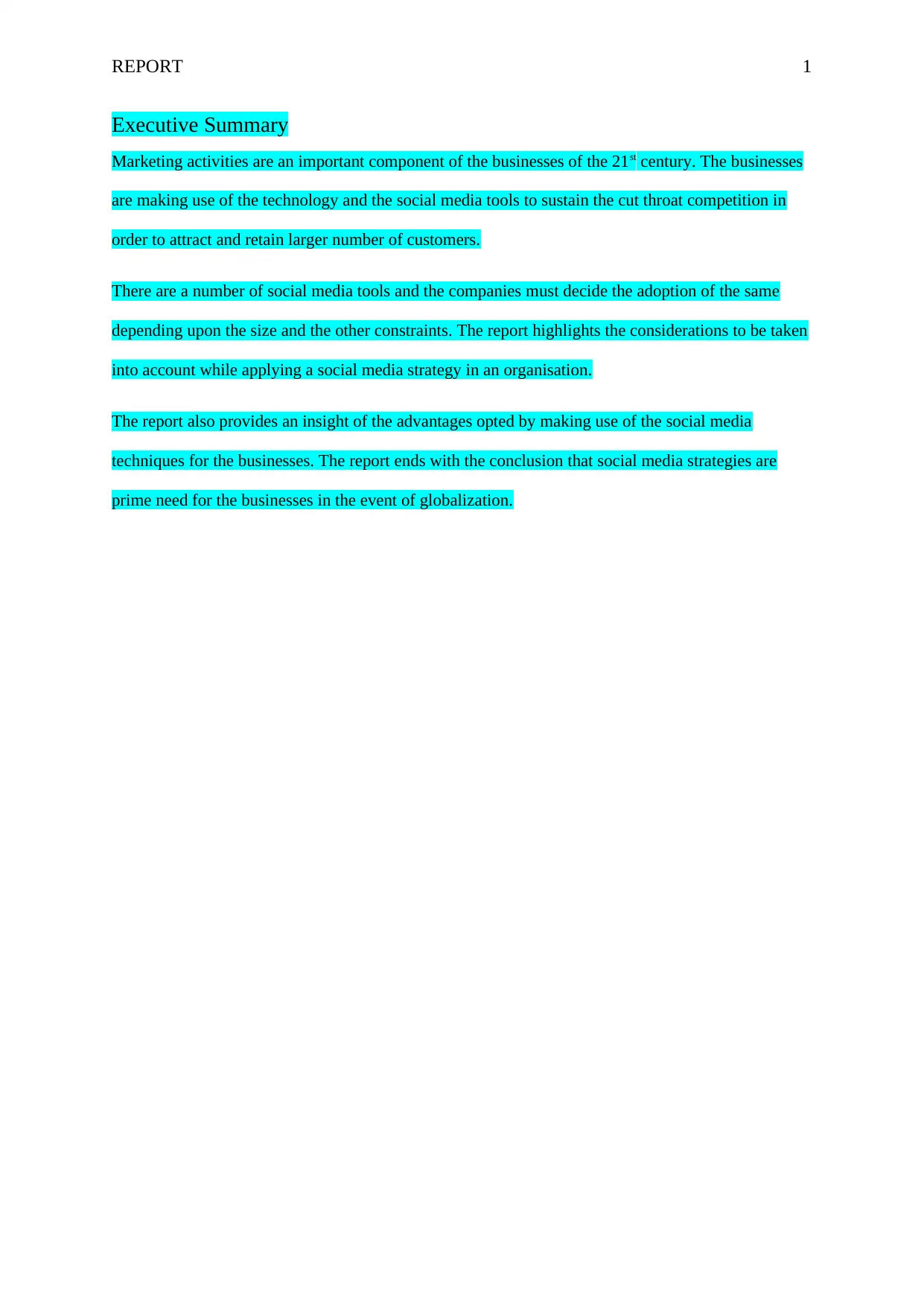
REPORT 1
Executive Summary
Marketing activities are an important component of the businesses of the 21st century. The businesses
are making use of the technology and the social media tools to sustain the cut throat competition in
order to attract and retain larger number of customers.
There are a number of social media tools and the companies must decide the adoption of the same
depending upon the size and the other constraints. The report highlights the considerations to be taken
into account while applying a social media strategy in an organisation.
The report also provides an insight of the advantages opted by making use of the social media
techniques for the businesses. The report ends with the conclusion that social media strategies are
prime need for the businesses in the event of globalization.
Executive Summary
Marketing activities are an important component of the businesses of the 21st century. The businesses
are making use of the technology and the social media tools to sustain the cut throat competition in
order to attract and retain larger number of customers.
There are a number of social media tools and the companies must decide the adoption of the same
depending upon the size and the other constraints. The report highlights the considerations to be taken
into account while applying a social media strategy in an organisation.
The report also provides an insight of the advantages opted by making use of the social media
techniques for the businesses. The report ends with the conclusion that social media strategies are
prime need for the businesses in the event of globalization.
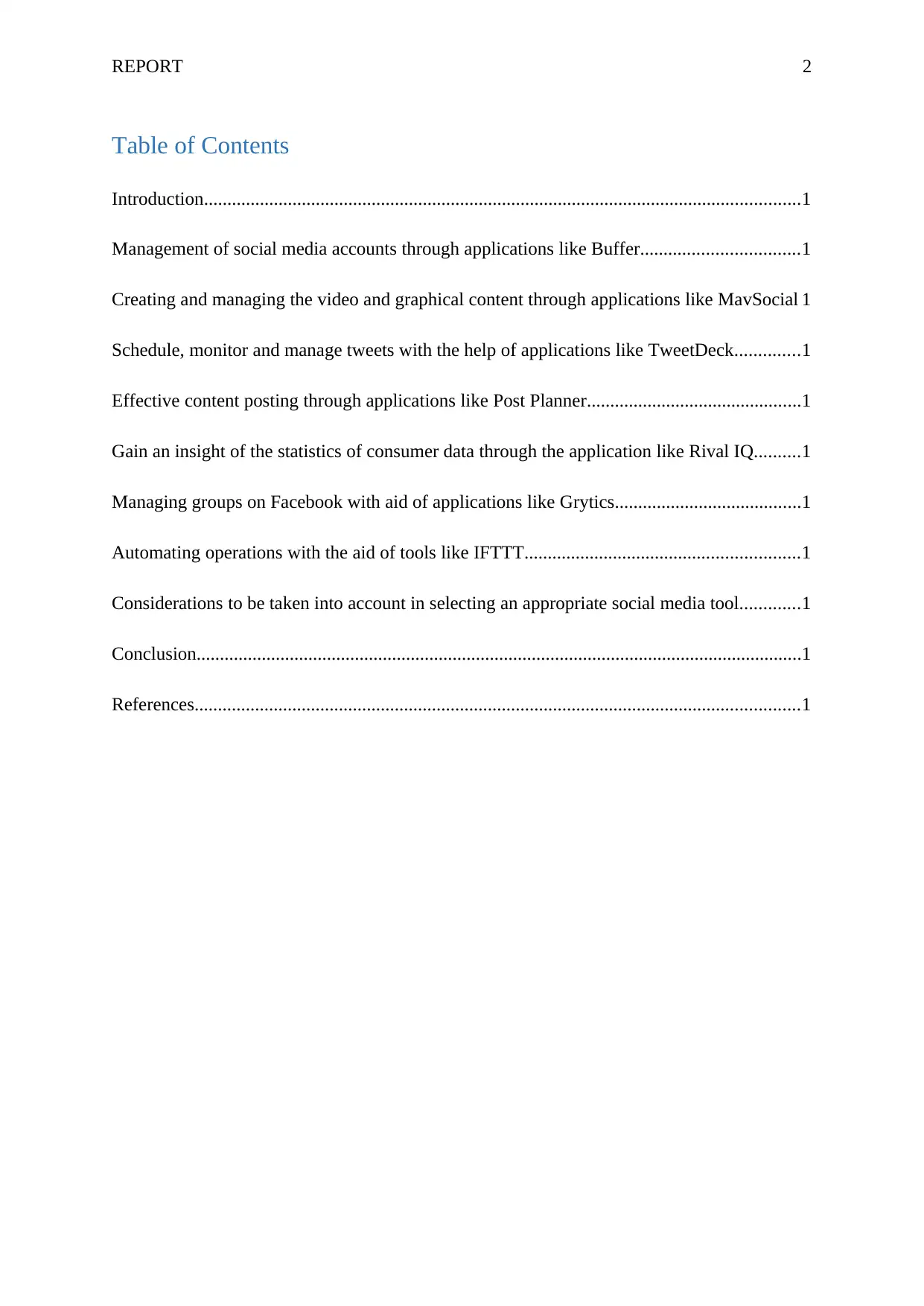
REPORT 2
Table of Contents
Introduction................................................................................................................................1
Management of social media accounts through applications like Buffer..................................1
Creating and managing the video and graphical content through applications like MavSocial 1
Schedule, monitor and manage tweets with the help of applications like TweetDeck..............1
Effective content posting through applications like Post Planner..............................................1
Gain an insight of the statistics of consumer data through the application like Rival IQ..........1
Managing groups on Facebook with aid of applications like Grytics........................................1
Automating operations with the aid of tools like IFTTT...........................................................1
Considerations to be taken into account in selecting an appropriate social media tool.............1
Conclusion..................................................................................................................................1
References..................................................................................................................................1
Table of Contents
Introduction................................................................................................................................1
Management of social media accounts through applications like Buffer..................................1
Creating and managing the video and graphical content through applications like MavSocial 1
Schedule, monitor and manage tweets with the help of applications like TweetDeck..............1
Effective content posting through applications like Post Planner..............................................1
Gain an insight of the statistics of consumer data through the application like Rival IQ..........1
Managing groups on Facebook with aid of applications like Grytics........................................1
Automating operations with the aid of tools like IFTTT...........................................................1
Considerations to be taken into account in selecting an appropriate social media tool.............1
Conclusion..................................................................................................................................1
References..................................................................................................................................1
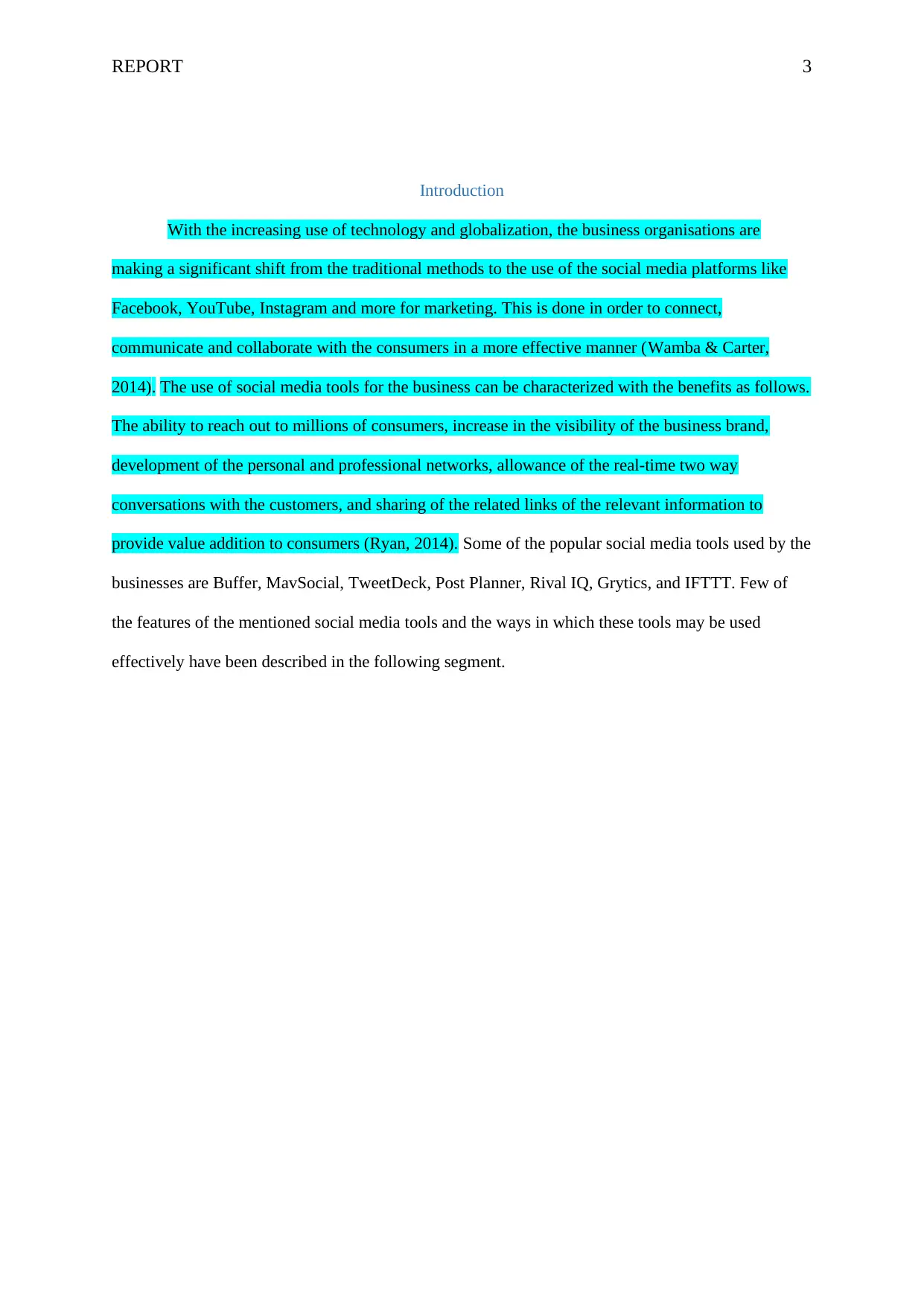
REPORT 3
Introduction
With the increasing use of technology and globalization, the business organisations are
making a significant shift from the traditional methods to the use of the social media platforms like
Facebook, YouTube, Instagram and more for marketing. This is done in order to connect,
communicate and collaborate with the consumers in a more effective manner (Wamba & Carter,
2014). The use of social media tools for the business can be characterized with the benefits as follows.
The ability to reach out to millions of consumers, increase in the visibility of the business brand,
development of the personal and professional networks, allowance of the real-time two way
conversations with the customers, and sharing of the related links of the relevant information to
provide value addition to consumers (Ryan, 2014). Some of the popular social media tools used by the
businesses are Buffer, MavSocial, TweetDeck, Post Planner, Rival IQ, Grytics, and IFTTT. Few of
the features of the mentioned social media tools and the ways in which these tools may be used
effectively have been described in the following segment.
Introduction
With the increasing use of technology and globalization, the business organisations are
making a significant shift from the traditional methods to the use of the social media platforms like
Facebook, YouTube, Instagram and more for marketing. This is done in order to connect,
communicate and collaborate with the consumers in a more effective manner (Wamba & Carter,
2014). The use of social media tools for the business can be characterized with the benefits as follows.
The ability to reach out to millions of consumers, increase in the visibility of the business brand,
development of the personal and professional networks, allowance of the real-time two way
conversations with the customers, and sharing of the related links of the relevant information to
provide value addition to consumers (Ryan, 2014). Some of the popular social media tools used by the
businesses are Buffer, MavSocial, TweetDeck, Post Planner, Rival IQ, Grytics, and IFTTT. Few of
the features of the mentioned social media tools and the ways in which these tools may be used
effectively have been described in the following segment.
Paraphrase This Document
Need a fresh take? Get an instant paraphrase of this document with our AI Paraphraser

REPORT 4
Management of social media accounts through applications like Buffer
One of the most popular social media tools is Buffer, which offers an instant solution to
businesses already having multiple social media accounts across various channels. The application
like these can be used for marketing as it allows the lining up of posts for the various social media
accounts. It also aids in group collaborations and analysis of data of the social media performance
across various platforms (Tuten & Solomon, 2017). Thus the social media tools like Buffer may be
used by the businesses in systematic organization of the social media accounts and managing the
overall marketing activities.
Creating and managing the video and graphical content through applications like MavSocial
Videos are a highly influential medium of marketing. The social media tools like MavSocial are
focused towards creation and management of the graphics and the videos for the social media
platforms like the Facebook, Twitter, Instagram, and YouTube. The applications like these can be
used by the business for scheduling or preview the content. The other features may be used for the
collaboration purposes, the creation of campaigns and for storing the images and videos (Huotari,
Ulkuniemi, Saraniemi & Mäläskä, 2015).
Schedule, monitor and manage tweets with the help of applications like TweetDeck
This social media tool is an aid to social media channel Twitter. The tool enables the
businesses to schedule, monitor and manage the tweets to be posted on Twitter (Grégoire, Salle, &
Tripp, 2015). In addition to this, the application helps in analysis of the data of the consumer's
preferences and accordingly, the business organizations can design and post tweets that are in line
with the taste of the customers. This way it is easy to keep the consumers hooked up to the entity.
Effective content posting through applications like Post Planner
One of the trickiest part of the marketing management on social media is posting of the right
content at the right time. The application like Post Planner makes use of the algorithms to analyse the
trending topics among the consumers and thus provides a recommendation of the topics (PostPlanner,
Management of social media accounts through applications like Buffer
One of the most popular social media tools is Buffer, which offers an instant solution to
businesses already having multiple social media accounts across various channels. The application
like these can be used for marketing as it allows the lining up of posts for the various social media
accounts. It also aids in group collaborations and analysis of data of the social media performance
across various platforms (Tuten & Solomon, 2017). Thus the social media tools like Buffer may be
used by the businesses in systematic organization of the social media accounts and managing the
overall marketing activities.
Creating and managing the video and graphical content through applications like MavSocial
Videos are a highly influential medium of marketing. The social media tools like MavSocial are
focused towards creation and management of the graphics and the videos for the social media
platforms like the Facebook, Twitter, Instagram, and YouTube. The applications like these can be
used by the business for scheduling or preview the content. The other features may be used for the
collaboration purposes, the creation of campaigns and for storing the images and videos (Huotari,
Ulkuniemi, Saraniemi & Mäläskä, 2015).
Schedule, monitor and manage tweets with the help of applications like TweetDeck
This social media tool is an aid to social media channel Twitter. The tool enables the
businesses to schedule, monitor and manage the tweets to be posted on Twitter (Grégoire, Salle, &
Tripp, 2015). In addition to this, the application helps in analysis of the data of the consumer's
preferences and accordingly, the business organizations can design and post tweets that are in line
with the taste of the customers. This way it is easy to keep the consumers hooked up to the entity.
Effective content posting through applications like Post Planner
One of the trickiest part of the marketing management on social media is posting of the right
content at the right time. The application like Post Planner makes use of the algorithms to analyse the
trending topics among the consumers and thus provides a recommendation of the topics (PostPlanner,
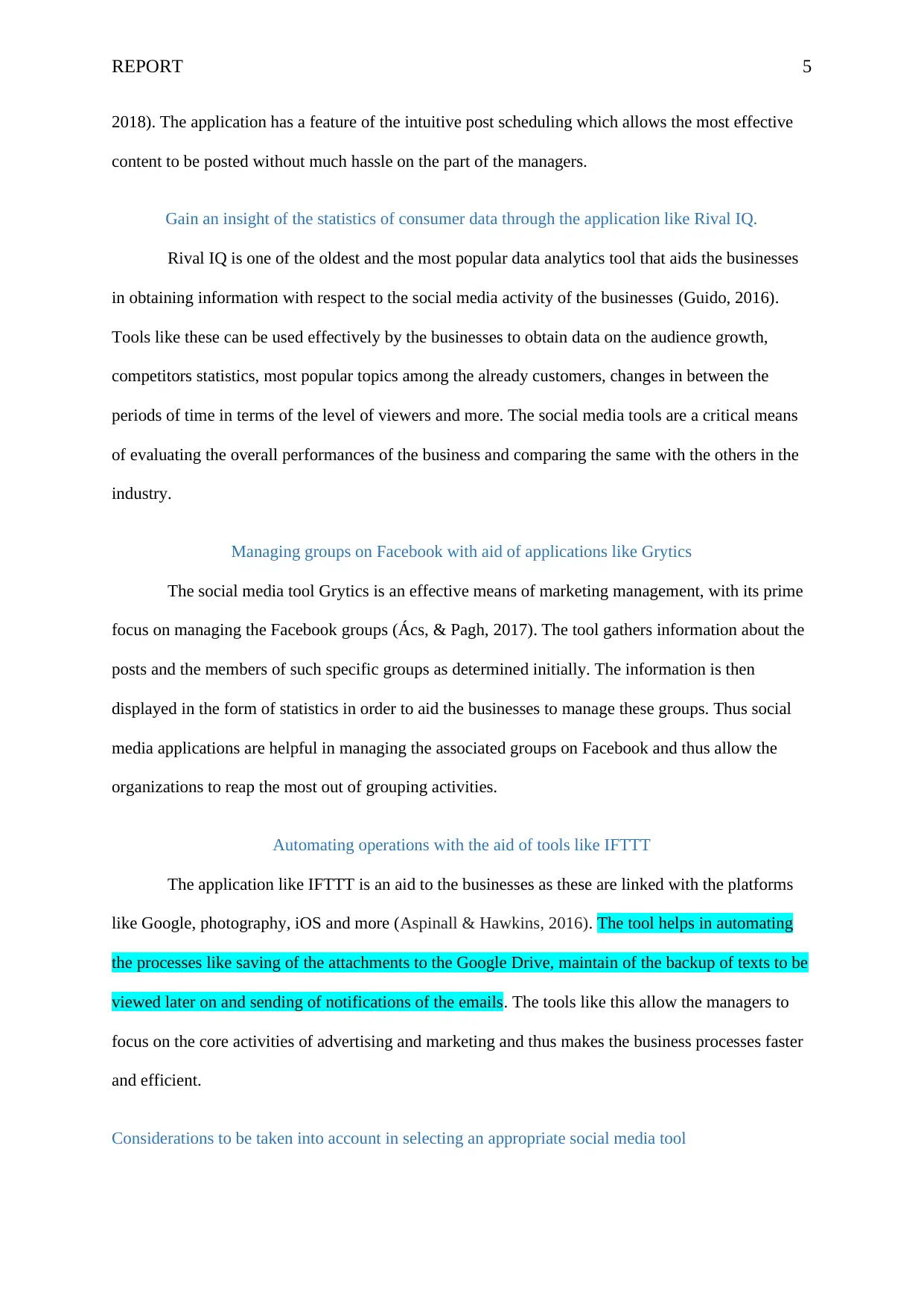
REPORT 5
2018). The application has a feature of the intuitive post scheduling which allows the most effective
content to be posted without much hassle on the part of the managers.
Gain an insight of the statistics of consumer data through the application like Rival IQ.
Rival IQ is one of the oldest and the most popular data analytics tool that aids the businesses
in obtaining information with respect to the social media activity of the businesses (Guido, 2016).
Tools like these can be used effectively by the businesses to obtain data on the audience growth,
competitors statistics, most popular topics among the already customers, changes in between the
periods of time in terms of the level of viewers and more. The social media tools are a critical means
of evaluating the overall performances of the business and comparing the same with the others in the
industry.
Managing groups on Facebook with aid of applications like Grytics
The social media tool Grytics is an effective means of marketing management, with its prime
focus on managing the Facebook groups (Ács, & Pagh, 2017). The tool gathers information about the
posts and the members of such specific groups as determined initially. The information is then
displayed in the form of statistics in order to aid the businesses to manage these groups. Thus social
media applications are helpful in managing the associated groups on Facebook and thus allow the
organizations to reap the most out of grouping activities.
Automating operations with the aid of tools like IFTTT
The application like IFTTT is an aid to the businesses as these are linked with the platforms
like Google, photography, iOS and more (Aspinall & Hawkins, 2016). The tool helps in automating
the processes like saving of the attachments to the Google Drive, maintain of the backup of texts to be
viewed later on and sending of notifications of the emails. The tools like this allow the managers to
focus on the core activities of advertising and marketing and thus makes the business processes faster
and efficient.
Considerations to be taken into account in selecting an appropriate social media tool
2018). The application has a feature of the intuitive post scheduling which allows the most effective
content to be posted without much hassle on the part of the managers.
Gain an insight of the statistics of consumer data through the application like Rival IQ.
Rival IQ is one of the oldest and the most popular data analytics tool that aids the businesses
in obtaining information with respect to the social media activity of the businesses (Guido, 2016).
Tools like these can be used effectively by the businesses to obtain data on the audience growth,
competitors statistics, most popular topics among the already customers, changes in between the
periods of time in terms of the level of viewers and more. The social media tools are a critical means
of evaluating the overall performances of the business and comparing the same with the others in the
industry.
Managing groups on Facebook with aid of applications like Grytics
The social media tool Grytics is an effective means of marketing management, with its prime
focus on managing the Facebook groups (Ács, & Pagh, 2017). The tool gathers information about the
posts and the members of such specific groups as determined initially. The information is then
displayed in the form of statistics in order to aid the businesses to manage these groups. Thus social
media applications are helpful in managing the associated groups on Facebook and thus allow the
organizations to reap the most out of grouping activities.
Automating operations with the aid of tools like IFTTT
The application like IFTTT is an aid to the businesses as these are linked with the platforms
like Google, photography, iOS and more (Aspinall & Hawkins, 2016). The tool helps in automating
the processes like saving of the attachments to the Google Drive, maintain of the backup of texts to be
viewed later on and sending of notifications of the emails. The tools like this allow the managers to
focus on the core activities of advertising and marketing and thus makes the business processes faster
and efficient.
Considerations to be taken into account in selecting an appropriate social media tool

REPORT 6
In order to select an appropriate social media tool, it is important that the marketing manager
of an enterprise considers the following points, in order to gain the maximum out of the selected
strategy.
Awareness about the goals of designing a marketing strategy is a must (Laursen & Thorlund,
2017). As to whether the aim is to increase the awareness about the brand or to attract more
traffic onto your Facebook group or website. Since each of the social media tools is
specialised in one or the other thing, clarity of the goal of in terms of the aim of marketing is
critical.
Identification of the core issues as to why a new social media tool is necessary is must, as to
whether the need arose because of the inefficiency on a certain level of the existing tools or
as a part of the expansion strategy. This evaluation will help the management to decide the
perfect mix of applications and customization of the same.
Evaluation of the must-have features is important. All social media tools are different. A
feature in one may not be present in another one and thus, the must-have features as decided
by the top management must be listed initially itself before finalising a tool for the business.
Consideration of time, money and expertise needed by the tool is critical for the businesses.
A social media tool must be opted after due contemplation of the budget, in-house expert
capacities and the nature and size of the operations (Jefferson & Tanton, 2015). A
comparison must also be drawn with the marketing strategy of the competitors in the same
industry so as to gain the competitive advantage too. Free trials must be opted for before the
actual use.
Examination of the limitations in the considered option must be done. The options that are
customizable as per the individual needs must be preferred, so as to align the overall values
and vision of the entity with that of the marketing practices.
In order to select an appropriate social media tool, it is important that the marketing manager
of an enterprise considers the following points, in order to gain the maximum out of the selected
strategy.
Awareness about the goals of designing a marketing strategy is a must (Laursen & Thorlund,
2017). As to whether the aim is to increase the awareness about the brand or to attract more
traffic onto your Facebook group or website. Since each of the social media tools is
specialised in one or the other thing, clarity of the goal of in terms of the aim of marketing is
critical.
Identification of the core issues as to why a new social media tool is necessary is must, as to
whether the need arose because of the inefficiency on a certain level of the existing tools or
as a part of the expansion strategy. This evaluation will help the management to decide the
perfect mix of applications and customization of the same.
Evaluation of the must-have features is important. All social media tools are different. A
feature in one may not be present in another one and thus, the must-have features as decided
by the top management must be listed initially itself before finalising a tool for the business.
Consideration of time, money and expertise needed by the tool is critical for the businesses.
A social media tool must be opted after due contemplation of the budget, in-house expert
capacities and the nature and size of the operations (Jefferson & Tanton, 2015). A
comparison must also be drawn with the marketing strategy of the competitors in the same
industry so as to gain the competitive advantage too. Free trials must be opted for before the
actual use.
Examination of the limitations in the considered option must be done. The options that are
customizable as per the individual needs must be preferred, so as to align the overall values
and vision of the entity with that of the marketing practices.
Secure Best Marks with AI Grader
Need help grading? Try our AI Grader for instant feedback on your assignments.
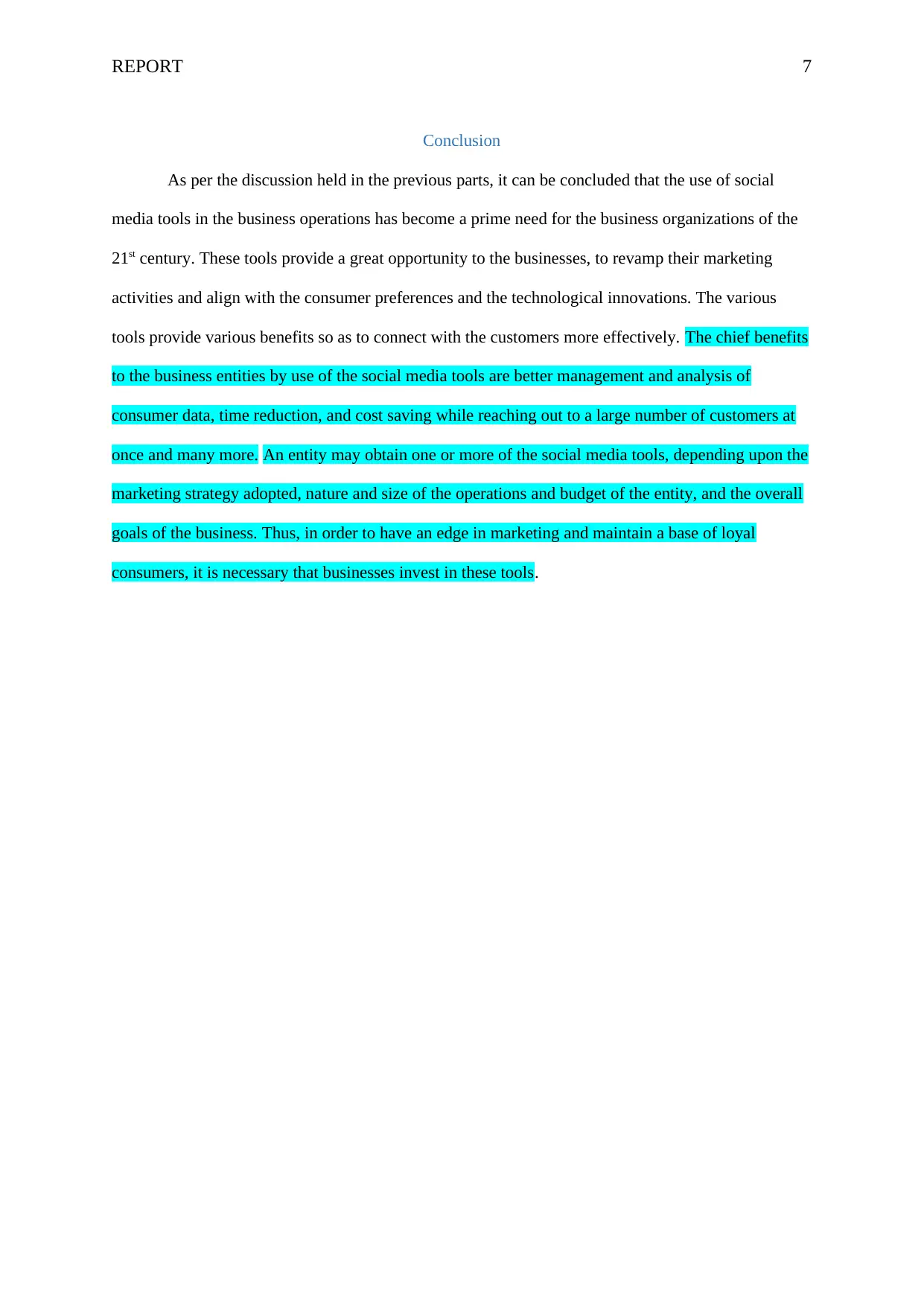
REPORT 7
Conclusion
As per the discussion held in the previous parts, it can be concluded that the use of social
media tools in the business operations has become a prime need for the business organizations of the
21st century. These tools provide a great opportunity to the businesses, to revamp their marketing
activities and align with the consumer preferences and the technological innovations. The various
tools provide various benefits so as to connect with the customers more effectively. The chief benefits
to the business entities by use of the social media tools are better management and analysis of
consumer data, time reduction, and cost saving while reaching out to a large number of customers at
once and many more. An entity may obtain one or more of the social media tools, depending upon the
marketing strategy adopted, nature and size of the operations and budget of the entity, and the overall
goals of the business. Thus, in order to have an edge in marketing and maintain a base of loyal
consumers, it is necessary that businesses invest in these tools.
Conclusion
As per the discussion held in the previous parts, it can be concluded that the use of social
media tools in the business operations has become a prime need for the business organizations of the
21st century. These tools provide a great opportunity to the businesses, to revamp their marketing
activities and align with the consumer preferences and the technological innovations. The various
tools provide various benefits so as to connect with the customers more effectively. The chief benefits
to the business entities by use of the social media tools are better management and analysis of
consumer data, time reduction, and cost saving while reaching out to a large number of customers at
once and many more. An entity may obtain one or more of the social media tools, depending upon the
marketing strategy adopted, nature and size of the operations and budget of the entity, and the overall
goals of the business. Thus, in order to have an edge in marketing and maintain a base of loyal
consumers, it is necessary that businesses invest in these tools.
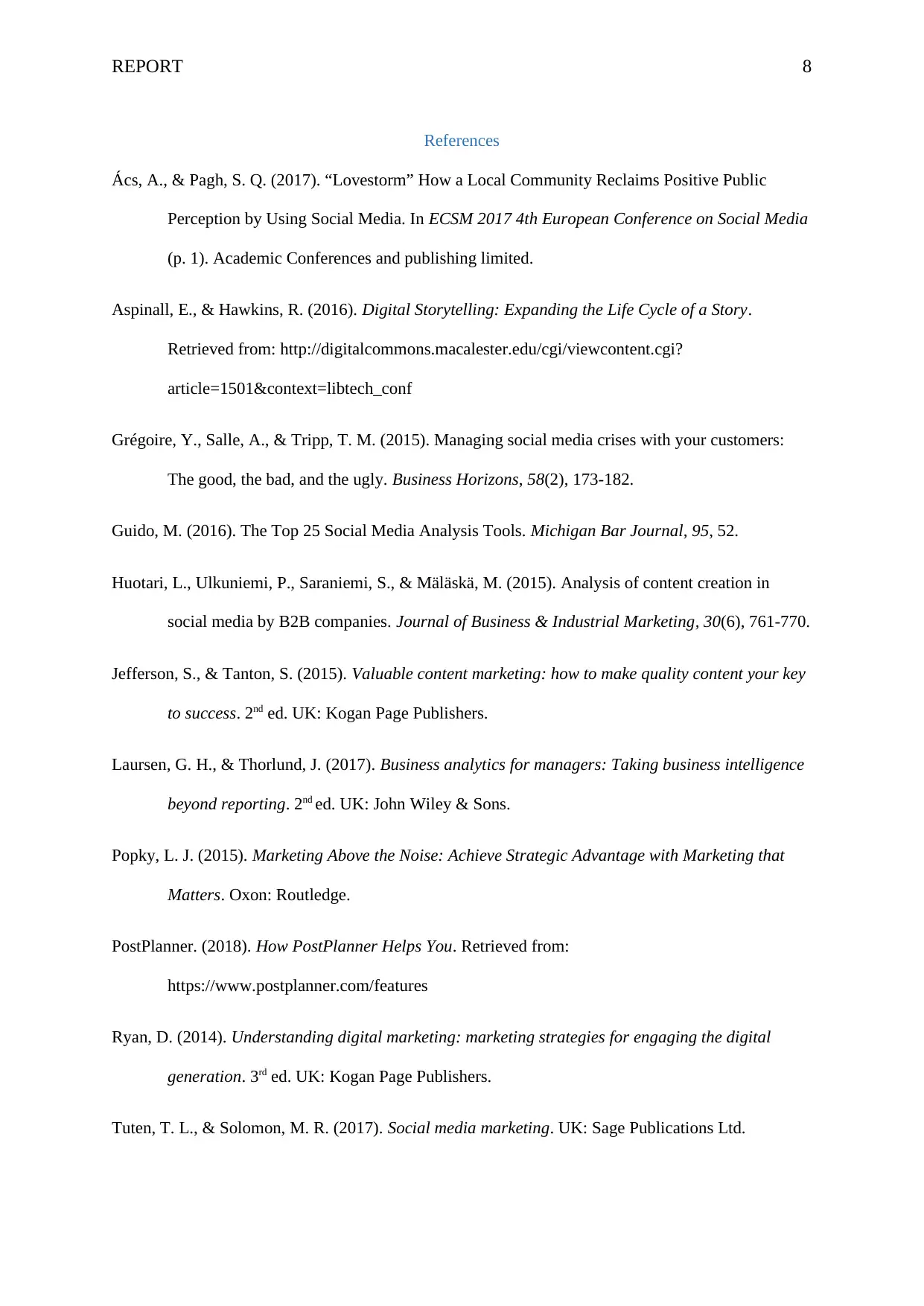
REPORT 8
References
Ács, A., & Pagh, S. Q. (2017). “Lovestorm” How a Local Community Reclaims Positive Public
Perception by Using Social Media. In ECSM 2017 4th European Conference on Social Media
(p. 1). Academic Conferences and publishing limited.
Aspinall, E., & Hawkins, R. (2016). Digital Storytelling: Expanding the Life Cycle of a Story.
Retrieved from: http://digitalcommons.macalester.edu/cgi/viewcontent.cgi?
article=1501&context=libtech_conf
Grégoire, Y., Salle, A., & Tripp, T. M. (2015). Managing social media crises with your customers:
The good, the bad, and the ugly. Business Horizons, 58(2), 173-182.
Guido, M. (2016). The Top 25 Social Media Analysis Tools. Michigan Bar Journal, 95, 52.
Huotari, L., Ulkuniemi, P., Saraniemi, S., & Mäläskä, M. (2015). Analysis of content creation in
social media by B2B companies. Journal of Business & Industrial Marketing, 30(6), 761-770.
Jefferson, S., & Tanton, S. (2015). Valuable content marketing: how to make quality content your key
to success. 2nd ed. UK: Kogan Page Publishers.
Laursen, G. H., & Thorlund, J. (2017). Business analytics for managers: Taking business intelligence
beyond reporting. 2nd ed. UK: John Wiley & Sons.
Popky, L. J. (2015). Marketing Above the Noise: Achieve Strategic Advantage with Marketing that
Matters. Oxon: Routledge.
PostPlanner. (2018). How PostPlanner Helps You. Retrieved from:
https://www.postplanner.com/features
Ryan, D. (2014). Understanding digital marketing: marketing strategies for engaging the digital
generation. 3rd ed. UK: Kogan Page Publishers.
Tuten, T. L., & Solomon, M. R. (2017). Social media marketing. UK: Sage Publications Ltd.
References
Ács, A., & Pagh, S. Q. (2017). “Lovestorm” How a Local Community Reclaims Positive Public
Perception by Using Social Media. In ECSM 2017 4th European Conference on Social Media
(p. 1). Academic Conferences and publishing limited.
Aspinall, E., & Hawkins, R. (2016). Digital Storytelling: Expanding the Life Cycle of a Story.
Retrieved from: http://digitalcommons.macalester.edu/cgi/viewcontent.cgi?
article=1501&context=libtech_conf
Grégoire, Y., Salle, A., & Tripp, T. M. (2015). Managing social media crises with your customers:
The good, the bad, and the ugly. Business Horizons, 58(2), 173-182.
Guido, M. (2016). The Top 25 Social Media Analysis Tools. Michigan Bar Journal, 95, 52.
Huotari, L., Ulkuniemi, P., Saraniemi, S., & Mäläskä, M. (2015). Analysis of content creation in
social media by B2B companies. Journal of Business & Industrial Marketing, 30(6), 761-770.
Jefferson, S., & Tanton, S. (2015). Valuable content marketing: how to make quality content your key
to success. 2nd ed. UK: Kogan Page Publishers.
Laursen, G. H., & Thorlund, J. (2017). Business analytics for managers: Taking business intelligence
beyond reporting. 2nd ed. UK: John Wiley & Sons.
Popky, L. J. (2015). Marketing Above the Noise: Achieve Strategic Advantage with Marketing that
Matters. Oxon: Routledge.
PostPlanner. (2018). How PostPlanner Helps You. Retrieved from:
https://www.postplanner.com/features
Ryan, D. (2014). Understanding digital marketing: marketing strategies for engaging the digital
generation. 3rd ed. UK: Kogan Page Publishers.
Tuten, T. L., & Solomon, M. R. (2017). Social media marketing. UK: Sage Publications Ltd.

REPORT 9
Wamba, S. F., & Carter, L. (2014). Social media tools adoption and use by SMEs: An empirical
study. Journal of Organizational and End User Computing. doi:
https://doi.org/10.4018/joeuc.2014040101
Wamba, S. F., & Carter, L. (2014). Social media tools adoption and use by SMEs: An empirical
study. Journal of Organizational and End User Computing. doi:
https://doi.org/10.4018/joeuc.2014040101
1 out of 10
Related Documents
Your All-in-One AI-Powered Toolkit for Academic Success.
+13062052269
info@desklib.com
Available 24*7 on WhatsApp / Email
![[object Object]](/_next/static/media/star-bottom.7253800d.svg)
Unlock your academic potential
© 2024 | Zucol Services PVT LTD | All rights reserved.





